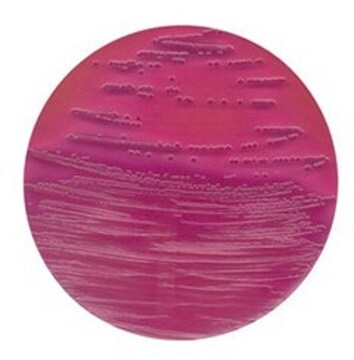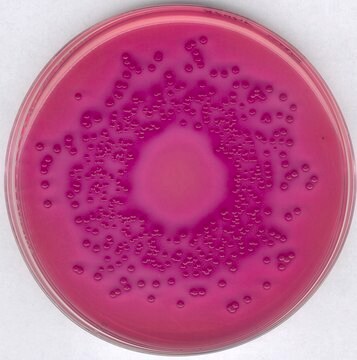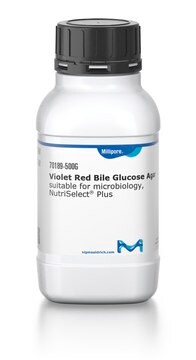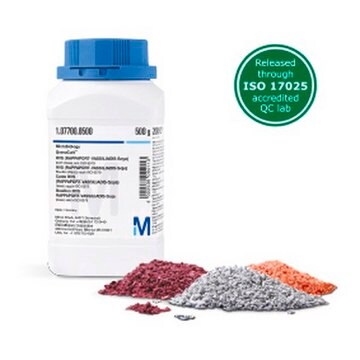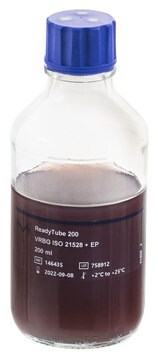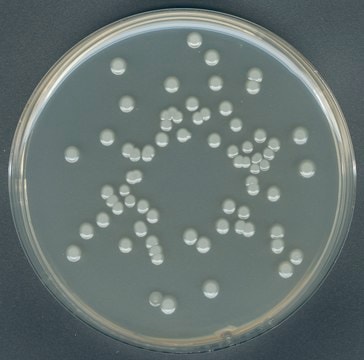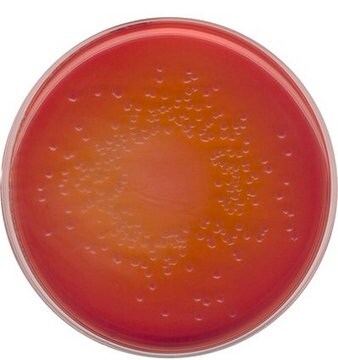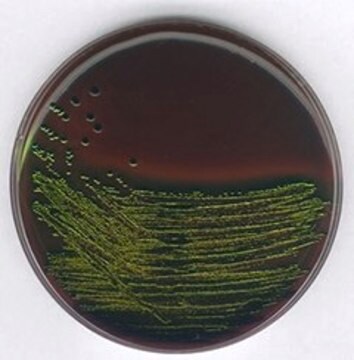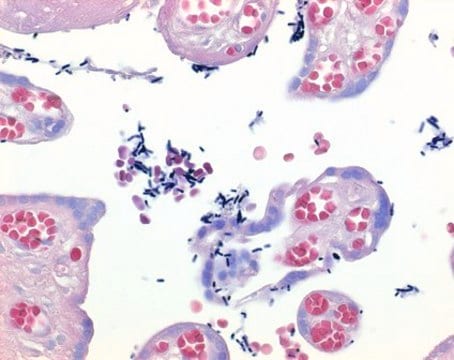1.04030
VRB (Violet Red Bile Lactose)-MUG agar
FluoroCult®, FDA-BAM, suitable for microbiology, for Escherichia coli, for coliforms
Synonim(y):
Coliform selective agar, MUG Violet Red Bile Agar, VRB-MUG agar, Violet Red Bile Agar with MUG, Violet Red Bile Lactose-MUG agar
About This Item
Polecane produkty
agency
FDA-BAM
Poziom jakości
Postać
medium granules (dehydrated (DCM))
opakowanie
pkg of 500 g
producent / nazwa handlowa
FluoroCult®
warunki przechowywania
(Keep tightly closed and dry.)
metody
microbiological culture: suitable
kolor
pink
pH
7.3-7.5 (25 °C, 39.6 g/L in H2O)
rozpuszczalność
39.6 g/L (after autoclaving)
gęstość nasypowa
620 kg/m3
Zastosowanie
food and beverages
microbiology
temp. przechowywania
15-25°C
przydatność
Escherichia coli
coliforms
Opis ogólny
Zastosowanie
Cechy i korzyści
- Fluorocult® fluorogenic culture media offer Rapid and Reliable culture testing
- Powerful alternatives to conventional microbiological methods for the rapid and sensitive detection of bacteria
- Offers superior granulated culture media
- Safe and sustainable due to reduced risks associated with fine dust and toxic substance inhalation, resulting in a safer work environment
- Excellent wettability, solubility, and free-flowing properties
- Convenient, with minimal component separation and clumping, even under warm or humid conditions
- High batch-to-batch reproducibility
- Prolonged shelf life of up to five years
- High number of test strains exceeding all regulatory demands
Komentarz do analizy
Appearance (color): dark red
pH-value (25 °C): 7.2 - 7.6
Solidification behaviour (2 hrs., 45 °C): liquid
Growth promotion test in accordance with the current version of DIN EN ISO 11133.
Growth(Escherichia coli ATCC 8739 (WDCM 00012)): good to very good
Growth Escherichia coliATCC 25922 (WDCM 00013): good to very good
Growth (Pseudomonas aeruginosa ATCC 27853 (WDCM 00025)): no limit
Growth (Enterococcus faecalis ATCC 19433 (WDCM 00009)): total inhibition
Growth (Enterococcus faecalis ATCC 29212 (WDCM 00087)): total inhibition
Colonies (Escherichia coli ATCC 8739 (WDCM 00012)): red with precipitation halo
Colonies (Escherichia coli ATCC 25922 (WDCM 00013)): red with precipitation halo
Colonies (Pseudomonas aeruginosa ATCC 27853 (WDCM 00025)): colourless to beige
Fluorescence (Escherichia coli ATCC 8739 (WDCM 00012)): + (poor)
Fluorescence (Escherichia coli ATCC 25922 (WDCM 00013)): +
Fluorescence (Pseudomonas aeruginosa ATCC 27853 (WDCM 00025)): + (greenish)
Incubation: 18 - 24 hours at 35 °C aerobic.
Informacje prawne
produkt powiązany
Kod klasy składowania
11 - Combustible Solids
Klasa zagrożenia wodnego (WGK)
WGK 3
Certyfikaty analizy (CoA)
Poszukaj Certyfikaty analizy (CoA), wpisując numer partii/serii produktów. Numery serii i partii można znaleźć na etykiecie produktu po słowach „seria” lub „partia”.
Masz już ten produkt?
Dokumenty związane z niedawno zakupionymi produktami zostały zamieszczone w Bibliotece dokumentów.
Nasz zespół naukowców ma doświadczenie we wszystkich obszarach badań, w tym w naukach przyrodniczych, materiałoznawstwie, syntezie chemicznej, chromatografii, analityce i wielu innych dziedzinach.
Skontaktuj się z zespołem ds. pomocy technicznej